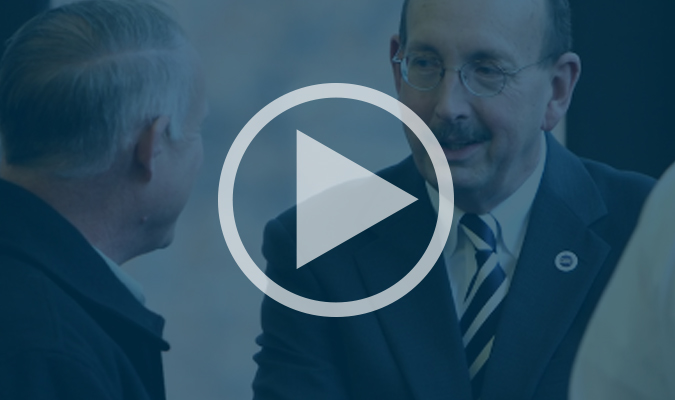History
The History of Dalton State Presidents
The History of Dalton State
| 1963 | Dalton Junior College chartered by the Board of Regents of the University System of Georgia. |
| 1965 | By 26 to 1, Whitfield County voters approve $1.8 million bond issue for new junior college. On 136 acres along I-75 in Dalton, construction begins on five original buildings: Westcott Hall, Sequoya Hall, Pope Student Center, Bandy Gymnasium and a maintenance/warehouse facility. |
| 1966 | Dr. Arthur M. Gignilliat named president of Dalton Junior College. |
| 1967 | Dalton Junior College opens to 524 students as the 24th institution of the University System of Georgia.
Dalton Junior College Foundation chartered. |
| 1969 | Dalton Junior College earns initial accreditation from the Southern Association of Colleges and Schools. |
| 1970 | College’s first president, Dr. Arthur M. Gignilliat, retires and Dr. Derrell C. Roberts assumes the presidency.
New classroom building, later named Elizabeth and Arthur Gignilliat Memorial Hall, is completed. |
| 1971 - 1972 | DJC Roadrunners celebrate undefeated regular season (34-0) and named GJCAA and NJCAA Region XVII champions. |
| 1972 | New library building, later named Derrell C. Roberts Library, completed. |
| 1973 | Creation of Technical Education Division authorized by University System and State Department of Education, bringing technical certificate and associate degree programs to the College’s pre-baccalaureate offerings. |
| 1973 - 1975 | Major additions added to Pope Student Center, Westcott Hall and maintenance/warehouse building. |
| 1977 - 1978 | Final season of the first era of Roadrunner basketball. |
| 1979 | Technical Education building completed. |
| 1989 | Major addition added to Sequoya Hall. |
| 1994 | College's second president, Dr. Roberts, retires.
Enrollment surpass 3,000. |
| 1995 | Dr. James A. Burran assumes presidency of the College. |
| 1996 | College assumes control of Dalton School of Health Occupations, adding new health-related programs to the curriculum. |
| 1998 | College switches from quarters to semesters per change in University System policy.
College authorized to begin developing first bachelor’s degrees, with implementations scheduled for 1999 and name changed to Dalton State College to reflect new baccalaureate mission. |
| 1999 | New three-story general classroom building is opened; building named the Shirley and Alan Lorberbaum Liberal Arts Building in 2001. |
| 2002 | Major addition added to the Roberts Library. |
| 2006 | Construction is completed and The James E. Brown Center for non-credit, continuing education programs opens. |
| 2007 | Enrollment surpasses 4,500.
Administrative reorganization of the College into seven Schools. Major renovation of Bandy Gymnasium completed to include a Fitness Center. The DSC Foundation’s “Fulfilling the Vision” campaign reaches $20 million goal, and total Foundation assets and pledges exceed $30 million. |
| 2008 | Bandy Heritage Center for Northwest Georgia established to serve as a site for research and scholarship and as a central location to house the region’s rich history.
Dr. James A. Burran retires; Dr. John O. Schwenn becomes the College’s fourth president. |
| 2009 | Dalton State Gilmer County Center opens in Ellijay, Georgia; over 200 students enroll.
Dr. John O. Schwenn inaugurated as College’s fourth president on May 1. Dalton State at Wood Valley residential housing opens. |
| 2010 | Enrollment surpasses 5,900.
Dalton State has $108 million impact on Northwest Georgia. Construction of College bell tower and redesign of central quadrangle completed; tower named for former President, Dr. James A. Burran. |
| 2011 | Students vote to re-establish intercollegiate athletics. |
| 2011 - 2012 | Dalton State sheds Technical College System of Georgia affiliation. |
| 2012 | Bachelor of Science in Nursing (RN-BSN) is approved by Board of Regents. |
| 2013 | Athletics return to Dalton State after a 35-year absence, with first teams fielded in men’s basketball, cross country, golf and tennis; women’s volleyball, cross country, golf and tennis and men’s and women’s competitive cheer; athletic program joins National Associations of Intercollegiate Athletics and Southern States Athletic Conference; major renovations completed to use College’s B.J. Bandy Gymnasium as home court for volleyball; Northwest Georgia Trade and Convention Center agrees to host Roadrunner basketball.
Administrative reorganization into five schools and ten departments. Dalton State Foundation gifts former CRI building to Department of Intercollegiate Athletics and renovation follows. College’s first Greek letter social fraternity, Alpha Kappa Lambda, colonizes. Bachelor of Arts in Interdisciplinary Studies and Bachelor of Science in Organizational Leadership is approved by Board of Regents. Campus trail system is completed and opens to the public. |
| 2014 | Bachelor of Science in Psychology is approved by Board of Regents.
College’s first Greek letter social sorority for women, Alpha Omicron Pi, colonizes. Men’s soccer is approved by Board of Regents, with first season scheduled for fall 2015. Construction is complete on new 58,000 square foot science building featuring state-of-the-art biology and chemistry labs; building is named for local philanthropists Shelby and Willena Peeples and chemistry labs named for donor John Willis Mashburn. Department of History is created under the School of Liberal Arts. Renovated athletics Center is named for College’s first basketball coach, Melvyn Ottinger. Renovation begins to transform former technical education building into a state-of-the-art home for health professions education. The First-Year Experience program begins a year-long discussion on inequality in America. The Dalton State women's cross country team earns the title of Southern States Athletic Conference Champions; the men's team comes in a close second. Dr. John O. Schwenn retires as president of the College. |
| 2015 | Dr. Margaret Venable becomes interim president of the College. She is named the fifth president of Dalton State in September.
Dalton State is named one of the “30 Most Affordable Schools for Outdoor Enthusiasts” on the website affordableschools.net. The Dalton State Roadrunners basketball team wins the NAIA National Championship; finishes the season with a 32-4 overall record. Jordon Bowling is named the tournament MVP. Ladaris Green is named to the first team NAIA All-American. Sean Tate receives second team honors. Bowling and Preston Earle are named to the All-Championship Team. A section of the Wood Valley Apartments is demolished and construction begins on new on-campus housing, Roadrunner Place. A Bachelor of Science in Criminal Justice is offered online, as well as on campus. The Board of Regents approves a Bachelor of Science in Health Information Management degree. An Associate of Arts in Music degree is offered. The Dalton State men's golf team wins the SSAC Tournament. Sean Elliott is the SSAC Tournament Individual Champion. He and Levi Nix are named to the SSAC All-Tournament team. Elliott, who broke an NAIA Championship scoring record, goes on to win the Arnold Palmer Trophy for NAIA Medalist and the Jack Nickalaus Award as NAIA Golfer of the Year. He is also named to the NAIA All-American team. Dalton State women's golf wins the SSAC Championship and ties for second in the NAIA National Championship. Golfers Julia McQuilken and Erika Wardzinski are named Conference Newcomers of the Year, and Caroline Griffin is named Freshman of the Year. McQuilken goes on to earn the Individual NAIA Tournament and is named to the first team NAIA All-American. Griffin is named to the second team NAIA All-American. |
| 2016 - Present |
Mashburn Hall opens. Dr. Margaret H. Venable is inaugurated as the fifth president of Dalton State in October. The former technical education building is renovated into the Health Professions Building. The Pope Student Center reopens after a renovation. |





